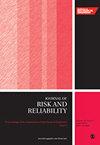考虑季节性天气影响的风力涡轮机可靠性分析
IF 1.8
4区 工程技术
Q3 ENGINEERING, INDUSTRIAL
Proceedings of the Institution of Mechanical Engineers Part O-Journal of Risk and Reliability
Pub Date : 2024-03-04
DOI:10.1177/1748006x241235727
引用次数: 0
摘要
由于季节性环境因素的影响,风力发电机的故障率会出现明显的波动。然而,很少有人致力于对季节性故障率进行建模。本文建立了一个由基准故障率函数、季节指数和残差项组成的新模型,用于描述风力发电机的月故障率。模型中 16 个未知参数的估算分为两个阶段。第一阶段通过最大似然估计法探索基线函数参数与月系数之间的关系,然后将属性整合到遗传算法中以估计主要参数。在第二阶段,根据对观察故障率和预测故障率之间差异的分析,估计残差项的方差。48 个月的故障历史被用来说明所提出的方法。结果表明,月故障率函数能很好地拟合风机的实际故障历史,其性能优于传统的可靠性模型。本文章由计算机程序翻译,如有差异,请以英文原文为准。
Reliability analysis of wind turbines considering seasonal weather effects
The failure rate of wind turbines shows obvious fluctuation due to seasonal environmental factors. However, few efforts have been devoted to modeling the seasonal failure rate. This paper develops a novel model that consists of a baseline failure rate function, seasonal indices, and a residual term to describe the monthly failure rate of wind turbines. A two-stage procedure is developed to estimate the 16 unknown parameters in the model. The first stage explores the relationship between the parameters in the baseline function and the monthly coefficients by maximum likelihood estimation and then integrates the properties into the genetic algorithm to estimate the main parameters. In the second stage, the variance of the residual term is estimated based on the analysis of the differences between the observed and predicted failure rates. The failure history of 48 months has been used to illustrate the proposed approach. The results show that the monthly failure rate function can well fit the real failure history of wind turbines, and it outperforms the traditional reliability model.
求助全文
通过发布文献求助,成功后即可免费获取论文全文。
去求助
来源期刊

Proceedings of the Institution of Mechanical Engineers Part O-Journal of Risk and Reliability
ENGINEERING, MULTIDISCIPLINARY-ENGINEERING, INDUSTRIAL
CiteScore
4.50
自引率
19.00%
发文量
81
审稿时长
6-12 weeks
期刊介绍:
The Journal of Risk and Reliability is for researchers and practitioners who are involved in the field of risk analysis and reliability engineering. The remit of the Journal covers concepts, theories, principles, approaches, methods and models for the proper understanding, assessment, characterisation and management of the risk and reliability of engineering systems. The journal welcomes papers which are based on mathematical and probabilistic analysis, simulation and/or optimisation, as well as works highlighting conceptual and managerial issues. Papers that provide perspectives on current practices and methods, and how to improve these, are also welcome
 求助内容:
求助内容: 应助结果提醒方式:
应助结果提醒方式:


